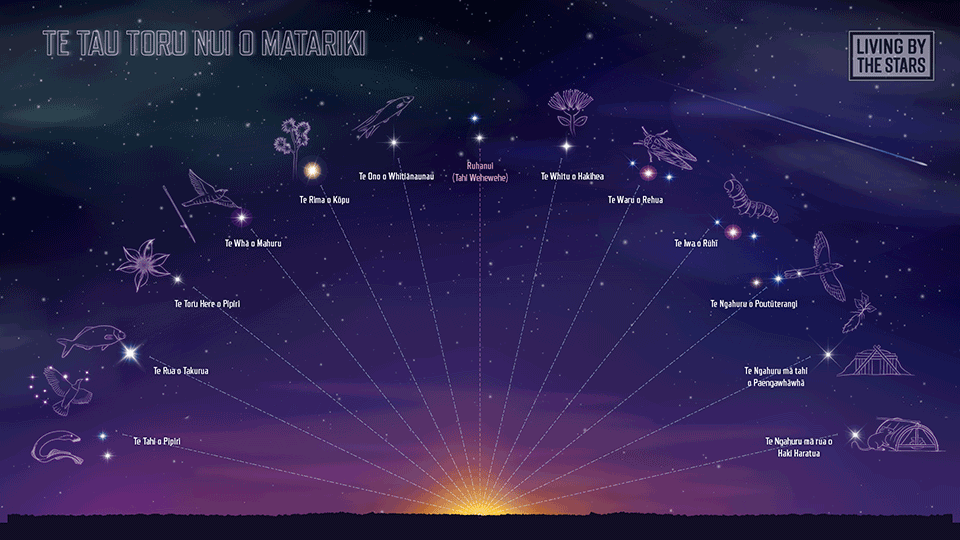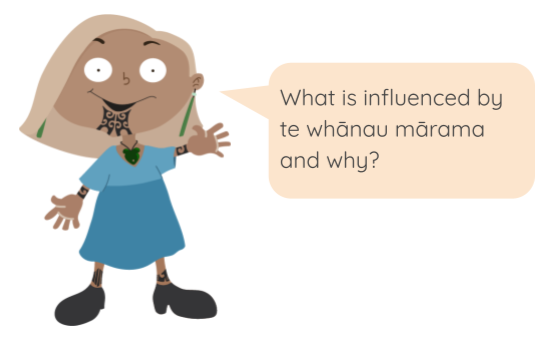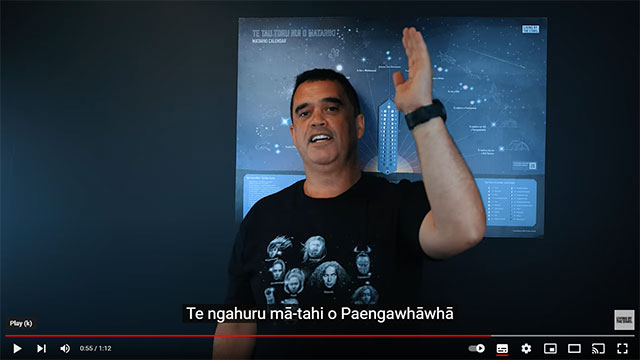<--Matariki: A wānanga with Dr Rangi Matamua
The study of the sky has been happening ever since people looked up and wondered. Astronomers are wise observers of the night sky. They noticed that when Earth moves through the seasons, different stars rise with the sun.
Māori astronomers provide a unique understanding of the sky above Aotearoa New Zealand. They observe, assess and draw conclusions based on the predictable movement of the moon, stars and planets across the sky.
One of the best ways of remembering new information is through stories and metaphors which explain complex ideas e.g. the stars form a canoe travelling through the sky.
This image shows the maramataka (the Māori lunar calendar) and corresponding star movements. Each lunar month is identified by the star, or stars, which rise with the sun during the night of the new moon. The month of Ruhanui is added during the winter of the third year of the three year calendar.

Image: Te Tau Nui o Matariki, ©Living by the Stars
Waiata - Ngā marama o te tau Māori
In this waiata, Dr Rangi Matamua sings about the months of the year. The waiata and hand actions are used to measure the position of whetu (stars) in the sky and identify the time of year.
Waiata - Ngā marama o te tau Māori
Te Tahi o Pipiri
Te Rua o Takurua
Te Toru Here o Pipiri
Te Whā o Mahuru
Te Rima o Kōpū
Te Ono o Whitiānaunau e
Te Whitu o Hakihea
Te Waru o Rehua
Te Iwa o Rūhī
Te ngahuru o Poutūterangi
Te ngahuru-mā-tahi o Paengawhāwhā
Te ngahuru-mā-rua o Haki Haratua
(2x)
Te Tahi o Pipiri
Tahi wehewehe
Ruhanui
Te tau toru nui o Matariki e
© Rangi Matamua 2021. All rights reserved (Reproduced with permission)
Seasons and stars
Observation and sharing knowledge is how we learn about season changes linked to the sun, moon and stars. Ocean tides and churn, the best time to plant, harvest, fish, hunt, work, and rest are all influenced by the energy of te whānau mārama (celestial bodies).
By paying attention to the stars and living in harmony with the seasons we can engage in more sustainable practises, like catching fish when fish are plentiful rather than all year.
People used to spend more time observing the sky. Now we have more information and spend less time observing our surroundings. We can learn to synchronise with the environment by observing activity in the sky and understanding the energy of the present moment.

Key words / Rerenga kōrero
| Te whānau mārama | celestial bodies (stars, planets, constellations, meteors, Sun and Moon) |
| Ruhanui | the extra month of the maramataka added in the third year |





